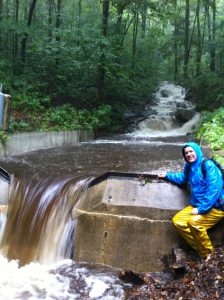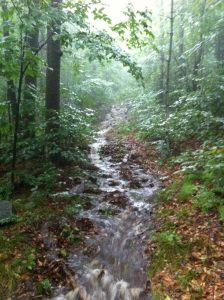There I was, checking the weather forecast for the last few days of my field season, writing in dismay on the blog that I would return home with no storm samples. (See the post below) The forecast had been the same as it was seemingly all summer: 40% chance of thunderstorms. At this point 40% may as well have read: “go enjoy a nice, sunny, and oppressively humid day outdoors!” I checked Hubbard Brook’s real time data from the night before, since it had rained a bit, and it looked like it had rained maybe a half inch overnight. I heard whispers of gage malfunctions and potential precip totals of ~3 inches in the experimental watersheds, but wasn’t going to get my hopes up. I knew better: it hadn’t rained, nor would it in the future, this was a clever tease for my last day.
Scott and I talked about trying to sample on Sunday if the slow but persistant rain we had continued throughout the weekend. I accepted this as a possibility and continued to wrap things up, knowing there wouldn’t be anything to sample.

Then I got a phone call from Scott, who was on his way home. It was bothering him that he was seeing so much water around, so he called Don Buso back at the station and asked him what was up. Don confirmed that several inches of rain were indeed recorded in the experimental watersheds. And the rain was intensifying, with some big cells on their way. Go time! Scott and I decided to head out and see what we could sample!
The road leading to watershed 3 had a couple feet of water flowing over it when we arrived. As seen in the picture, the water going through the weir was almost out of the v-notch! As indicated by debris we noticed on our way down, the flow was out of the v-notch briefly while we were sampling in the catchment!! We began pumping wells for samples. Heading up to join Scott at a well, after sampling the main watershed 3 stream, I thought I would try to get some throughfall from the collectors I installed earlier in the summer. The ~3 m long, 2 cm wide throughs were meant to slowly collect throughfall through the duration of a storm, but it was really coming down. I put the outflow tube into a 125 ml bottle and tried to set it down somewhere so I could come back later to collect. I was amazed as before my eyes the bottle filled! It was raining very, very hard.
We were able to sample 25 of the 26 wells in our groundwater sampling scheme, the exception being a 2 m deep well into the unweathered till below the soil. This well is reliably wet in the fall and winter, and it being dry is a very promising indication that there are two very different storage regimes in the catchment, wetting up and delivering water to the stream in different ways.
Overland flow was everywhere, the road in the catchment was a stream (see photo), and Scott even saw saturation build up above the ground, which lifted up leaves on the forest floor, transporting them down slope. I was at a different site, but he says it was one of the most amazing hydrological phenomena he has ever seen!
We made it out of the catchment just before dark with about 140 total samples. The samples will be analyzed for several different isotopes and major and trace ions, hopefully yielding an endlessly valuable dataset! I think we are all extremely excited to see what we can say about what was going on in this major re-wetting and runoff generating event after an extended dry period.
